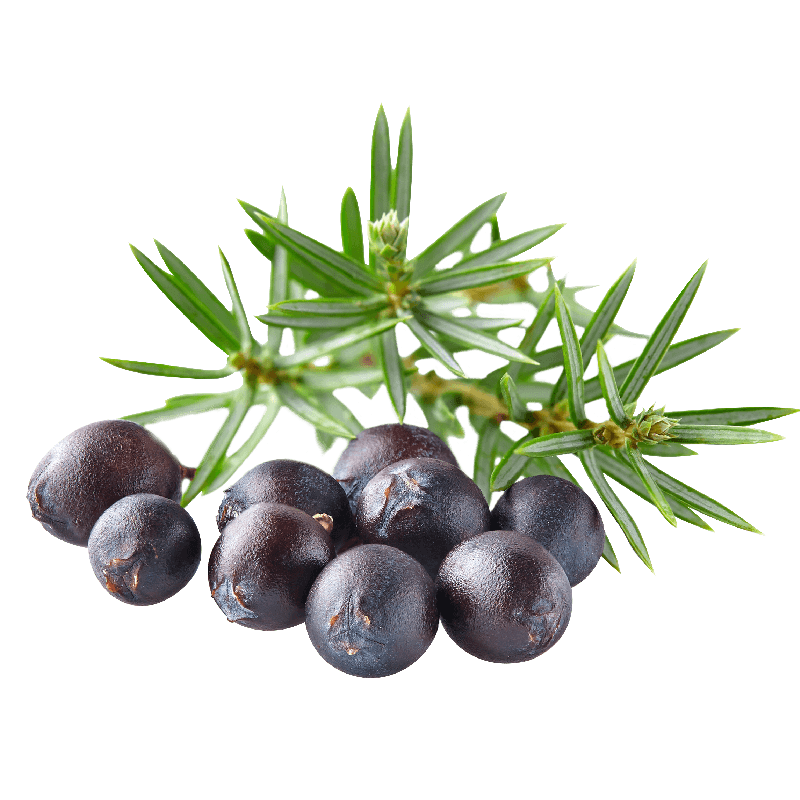
Juniper
Latin name
Origin
Used part
Active components
Usage
Bibliographical references
- Essential oils of Cupressus funebris, Juniperus communis, and J. chinensis (Cupressaceae) as repellents against ticks (Acari: Ixodidae) and mosquitoes (Diptera: Culicidae) and as toxicants against mosquitoes.
Carroll JF, Tabanca N, Kramer M, Elejalde NM, Wedge DE, Bernier UR, Coy M, Becnel JJ, Demirci B, Başer KH, Zhang J, Zhang S.
J Vector Ecol. 2011 Dec;36(2):258-68.
Pubmed: http://www.ncbi.nlm.nih.gov/pubmed/22129397 - Juniperus communis Linn oil decreases oxidative stress and increases antioxidant enzymes in the heart of rats administered a diet rich in cholesterol.
Gümral N, Doguc Kumbul D, Aylak F, Saygin M, Savik E.
Toxicol Ind Health. 2013 Jan 4.
Pubmed: http://www.ncbi.nlm.nih.gov/pubmed/23293127 - Chemical investigation of the essential oil from berries and needles of common juniper (Juniperus communis L.) growing wild in Estonia.
Nat Prod Res. 2010 Nov;24(19):1789-99.
Orav A, Kailas T, Muurisepp M.
Pubmed: http://www.ncbi.nlm.nih.gov/pubmed/21104523 - Essential oil of Juniperus communis subsp. alpina (Suter) Čelak needles: chemical composition, antifungal activity and cytotoxicity.
Cabral C, Francisco V, Cavaleiro C, Gonçalves MJ, Cruz MT, Sales F, Batista MT, Salgueiro L.
Phytother Res. 2012 Sep;26(9):1352-7
Pubmed: http://www.ncbi.nlm.nih.gov/pubmed/22294341 - Antioxidant and antimicrobial activities of branches extracts of five Juniperus species from Turkey.
Taviano MF, Marino A, Trovato A, Bellinghieri V, La Barbera TM, Güvenç A, Hürkul MM, Pasquale RD, Miceli N.
Pharm Biol. 2011 Oct;49(10):1014-22.
Pubmed: http://www.ncbi.nlm.nih.gov/pubmed/21592011 - Chemical composition and antibacterial activity of selected essential oils and some of their main compounds.
Wanner J, Schmidt E, Bail S, Jirovetz L, Buchbauer G, Gochev V, Girova T, Atanasova T, Stoyanova A.
Nat Prod Commun. 2010 Sep;5(9):1359-64.
Pubmed: http://www.ncbi.nlm.nih.gov/pubmed/20922991 - Antifungal activity of Juniperus essential oils against dermatophyte, Aspergillus and Candida strains.
Cavaleiro C, Pinto E, Gonçalves MJ, Salgueiro L.
J Appl Microbiol. 2006 Jun;100(6):1333-8.
Pubmed: http://www.ncbi.nlm.nih.gov/pubmed/16696681 - Antimicrobial activity of juniper berry essential oil (Juniperus communis L., Cupressaceae).
Pepeljnjak S, Kosalec I, Kalodera Z, Blazević N.
Acta Pharm. 2005 Dec;55(4):417-22.
Pubmed: http://www.ncbi.nlm.nih.gov/pubmed/16375831 - Chemical composition of the essential oils of Juniperus from ripe and unripe berries and leaves and their antimicrobial activity.
Angioni A, Barra A, Russo MT, Coroneo V, Dessi S, Cabras P.
J Agric Food Chem. 2003 May 7;51(10):3073-8.
Pubmed: http://www.ncbi.nlm.nih.gov/pubmed/12720394 - Biological activities of α-pinene and β-pinene enantiomers.
Rivas da Silva AC, Lopes PM, Barros de Azevedo MM, Costa DC, Alviano CS, Alviano DS.
Molecules. 2012 May 25;17(6):6305-16.
Pubmed: http://www.ncbi.nlm.nih.gov/pubmed/22634841 - Screening of five essential oils for identification of potential inhibitors of IL-1-induced Nf-kappaB activation and NO production in human chondrocytes: characterization of the inhibitory activity of alpha-pinene.
Neves A, Rosa S, Gonçalves J, Rufino A, Judas F, Salgueiro L, Lopes MC, Cavaleiro C, Mendes AF.
Planta Med. 2010 Feb;76(3):303-8.
Pubmed: http://www.ncbi.nlm.nih.gov/pubmed/19774507 - Effect of alpha-pinene on nuclear translocation of NF-kappa B in THP-1 cells.
Zhou JY, Tang FD, Mao GG, Bian RL.
Acta Pharmacol Sin. 2004 Apr;25(4):480-4.
Acta Pharmacologica Sinica: http://www.chinaphar.com/1671-4083/25/480.pdf - Bioinformatical and in vitro approaches to essential oil-induced matrix metalloproteinase inhibition.
Zeidán-Chuliá F, Rybarczyk-Filho JL, Gursoy M, Könönen E, Uitto VJ, Gursoy OV, Cakmakci L, Moreira JC, Gursoy UK.
Pharm Biol. 2012 Jun;50(6):675-86.
Pubmed: http://www.ncbi.nlm.nih.gov/pubmed/22571397
The health claims that feature on our website in relation to the plants contained in our products are compliant with the list of health claims awaiting final assessment by the Community authorities (cf. website of the European Commission: http://ec.europa.eu/nuhclaims/). However, they may be subject to modification following their assessment by the national competent authorities.
The health claims relating to other nutrients or substances contained in our products that feature on our site are compliant with Regulation No. 432/2012 of the Commission of 16 May 2012 which establishes a list of authorised health claims authorised in relation to food products, other than those in reference to the reduction of the risk of disease as well as community-based development and child health (cf. website of the European Commission: http://ec.europa.eu/nuhclaims/).

 Belgique
Belgique  België
België  France
France  Italia
Italia  Portugal
Portugal  España
España  United Kingdom
United Kingdom  Κύπρος
Κύπρος 